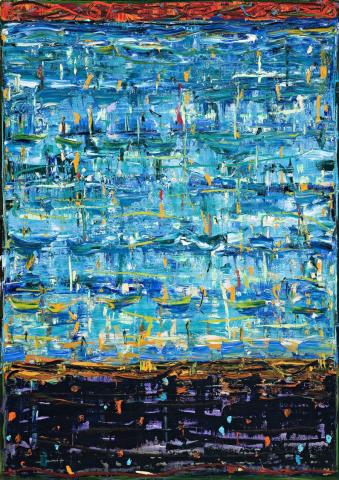JAROCIN BLUE, 1989
Michael Johnson
oil on canvas
213.0 x 152.0 cm
signed, dated and inscribed verso: (TOM’S PAINTING) / Michael Johnson 1989
The Lowenstein Sharp Collection of Contemporary Australian Art, Deutscher~Menzies, Melbourne, 11 November 2002, lot 18
Private collection, Melbourne
In 1968, when a group of young artists exhibited in The Field, the inaugural exhibition of the new building of the National Gallery of Victoria, their credo was all about the formal aspects of painting - of colour fields, flat surfaces, hard edges and the tyranny of the picture plane. A youthful Michael Johnson was one of them, his paintings Chomp and Frontal 2 celebrating colour and the contemporary cool of flatness. Absence of figuration and narrative was like a breath of fresh air. Painting was now all about painting without any external references. While colour still reigns supreme in his art, Johnson later introduced texture and line to give his surfaces a greater visual richness. Seemingly endless fields of gestural colour now spread in entwining, painterly layers, classically balanced and confined within his chosen vertical or horizontal format. A predilection for dividing his paintings into three zones reflects the traditional landscape layout. In addition, the layering of paint and colour, combined with the use of aerial perspective in the progression of foreground darks to middle ground lights, also suggests depth. Any such illusions, however, are readily brought back to the picture surface by the lively calligraphy of his brushstrokes. Like so much of his painting, Jarocin Blue invites exploration, not for the discovery of apparent truths, but for shared mood and experience. His paintings have a strong affinity with music. Johnson has likened himself to a conductor. 'I don't see any difference between the spirit of music and the spirit of painting'.1 This is reflected in such titles such as Jarocin Blue.
During the 1980s, the Polish town of Jarocin was the home of one of Europe's biggest and most important rock music festivals, the Jarocin Festival, and it was occasionally referred to as the 'Polish Woodstock'. The music of the three-day fest included 'alternative', rock, heavy metal, punk rock and blues. The visually fascinating richness of the fields of colour and textures in Johnson's Jarocin Blue express something of the lively atmosphere of the Festival. It is interesting to note, however, that although there is a strong feeling of energy and physicality about this and others of his paintings, and that he approaches them with gusto, they usually take three months or more to complete. Johnson has said that 'there are roughly seventeen layers on each.'2 Starting with the shape of the canvas and the picture's mood, Johnson 'compares himself to a musician, with the canvas as his instrument.'3 Jarocin Blue is a characteristic and highly engaging example of Johnson working at his best.
1. Johnson, M., quoted in Drury, N., Images 2: Contemporary Australian Painting, Craftsman House, Sydney, 1994, p. 182
2. The artist, quoted in McDonald, J., Studio: Australian Painters on the Nature of Creativity, R. Ian Lloyd Productions Pte Ltd, Singapore, 2007, p. 102
3. McDonald, ibid.
DAVID THOMAS
